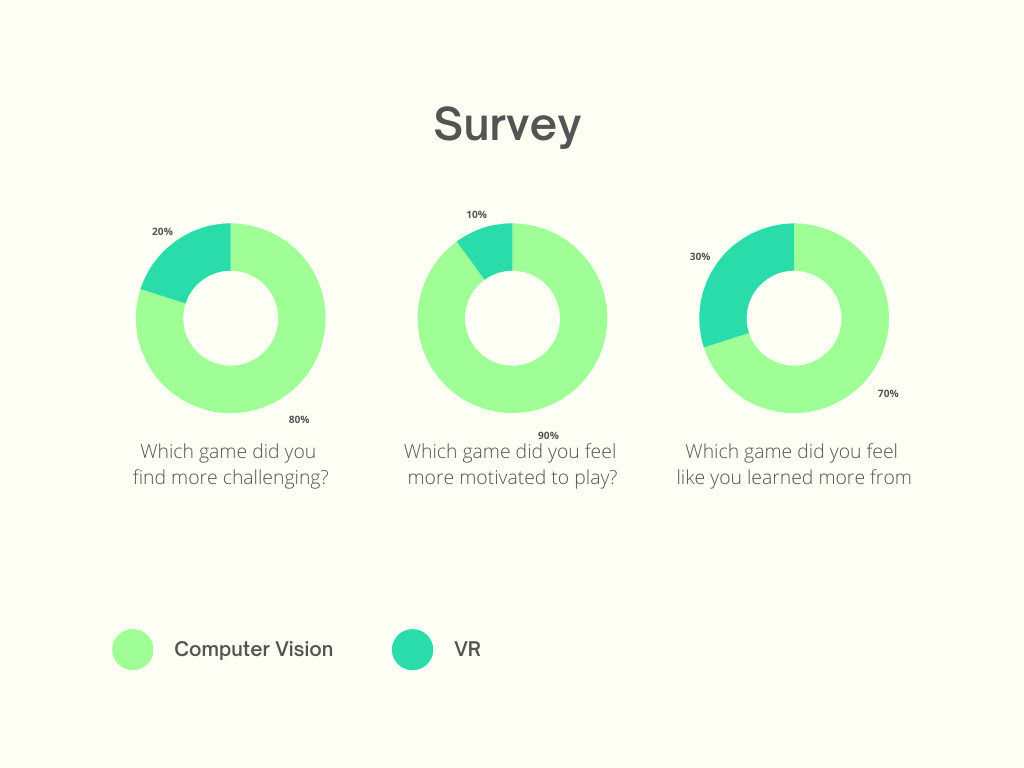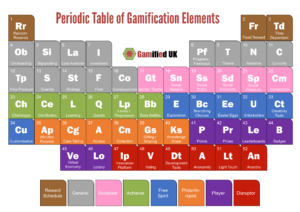Premise
Using computer vision to promote healthy food awareness among children through gamification.
Synopsis
Childhood obesity is a significant and growing public health concern, mainly due to environmental factors such as excessive sugar consumption and reduced physical activity. Children’s food choices can be influenced by their preferences, leading to unhealthy decisions. Educating children on informed food choices is essential to promoting healthier diets. Integrating nutrition education with computer vision technology and gamification offers an interactive and immersive approach to teaching children about healthy eating habits. Computer vision technology can enable the creation of interactive educational games, while gamification can increase motivation and engagement in learning activities. These tools can make nutrition education more enjoyable and effective for children.
Substantiation
Childhood obesity is an escalating global public health concern, predominantly due to negative environmental factors such as excessive sugar consumption, larger portions, and decreased physical activity (Sahoo et al., 2015). According to Reilly (2005), childhood obesity can lead to severe and long-lasting physical as well as psychological consequences that may persist into adulthood. There is a higher probability that children who are obese will develop obesity as adults, which raises the risk of numerous diseases and medical conditions (Reilly, 2005; Kelsey et al., 2014). Furthermore, childhood obesity is associated with various physical and mental health issues, including type 2 diabetes, cardiovascular disease, orthopedic complications, depression, and anxiety (Kelsey et al., 2014).
Parents often hold the primary decision-making power within families, but children significantly influence their parents’ food choices (Drummond, 2011). This influence can lead to unhealthy choices, mainly when parents are tired or preoccupied (Wingert et al., 2014). While making food-related decisions, parents may also consider the preferences of other family members, such as their children (Holsten et al., 2012). The impact of children’s preferences on parents’ food purchasing decisions has been well documented, with parents yielding to their children’s requests in 45-65% of cases (O’Dougherty et al., 2006). However, children can serve as catalysts for positive change by encouraging healthier food choices for their parents (Faith et al., 2012).
Educating children on informed food decision-making is vital in guiding them toward healthier dietary choices. As children mature and gain independence, they make their own food selections (Pérez-Rodrigo & Aranceta, 2001). Offering nutrition education classes in primary schools can foster healthy eating habits among students (Drummond, 2011). Advancing food and nutrition literacy can result in healthier food choices and diets for children and adolescents (Mohsen et al., 2022). Additionally, higher levels of food and nutrition literacy correlate with increased fruit and vegetable consumption and a preference for nutritious food (Mohsen et al., 2022).
Moreover, computer vision technology has transformed the development and delivery of educational games, providing students with an interactive and immersive learning experience that surpasses traditional teaching methods (Gari et al., 2020; Kusuma et al., 2018). Therefore, integrating nutrition education with computer vision technology could create a more interactive and practical approach to educating children on healthy eating habits.
Gamification promotes healthy habits by using game elements and techniques in non-game contexts. For example, food-based games that employ competition, cooperation, and guidelines can encourage healthy eating habits (Niewiadomski et al., 2019). Additionally, gamification has been proven to increase motivation, engagement, and achievement in learning activities (Kunsuma et al., 2018), making it an effective method to enhance learning experiences and promote healthier lifestyles by integrating computer vision technology.
Prototype
Iteration 1
In an effort to determine the most effective approach for teaching children aged 6 to 8 about healthy and unhealthy eating, the first iteration of this project sought to determine whether a VR environment or a computer vision game would be more engaging. The engagement levels of 10 children were measured during the prototype testing by observing their reaction. Prior to the testing phase, research was conducted to identify the most effective pedagogical approaches for children, which was then incorporated into the initial sketches.
The primary goal of the project was to provide an enjoyable and engaging learning experience for the children, while also imparting information about healthy and unhealthy food. The VR environment sketch was designed to be an immersive experience that provided a first-person view of various scenarios related to food choices, while the computer vision game sketch required children to identify healthy and unhealthy foods. By the end of the testing phase, the engagement levels of the children were measured using a survey, which provided valuable insights into the effectiveness of each approach.
Computer Vision concept game:
VR concept game:


Insights:
- The computer vision game may have been more age-appropriate for children aged 6-8, as it was designed to be simple and intuitive. According to the children, the virtual reality concept was less engaging and the concept was too difficult for them to fully enjoy.
- Competition: The computer vision game may have allowed for competition among the children, as they could compete to see who caught the most healthy or unhealthy food. This competition may have added an additional level of engagement to the game.
- The social aspect of the games may have also influenced the children’s preferences. Most people are socializers, as evidenced by studies and supported by various models, as the Bartle taxonomy of player types. Video games often include social elements, such as competition and teaching, which further indicate this tendency (Manzano-León et al., 2020).

Iteration 2
The second phase of development focused on utilizing computer vision and Python to enhance the functionality of the prototype. To ensure that the gamification elements were optimized for socializer gamers, I researched The Periodic Table of Gamification Elements and incorporated the most effective elements for this group.

Valuable insights gleaned from the preliminary testing stage informed the introduction of a point system, a background timer, and an instructive element aimed at educating children on the benefits and drawbacks of healthy versus unhealthy food choices. The mechanics of the game were refined to ensure that unhealthy food choices would result in game termination, emphasizing the importance of healthy eating habits.
Figma design
Python prototype:
Insights:
- Children in the testing group expressed a desire to learn more about why certain foods were considered unhealthy and why others were healthy. This feedback underscores the importance of providing children with relevant and accessible information about nutrition and health.
- Some children expressed a desire for additional chances to correct their mistakes when playing the game. A 3 lives heart game system, for example, creates a sense of urgency and encourages children to think carefully about their food choices. While it is important to create a sense of urgency and encourage children to make healthy food choices, it is also important to provide them with a reasonable number of chances to correct their mistakes and learn from their choices.
- During user testing, participants expressed a desire for encouraging messages, as this could help to motivate and reinforce their behavior. Positive reinforcement techniques have been found to be effective in encouraging healthy eating habits among children. (Chow et al., 2020).
Iteration 3
In the third iteration, several gamification elements were added to the computer vision prototype to enhance its educational value and increase children’s engagement. The inclusion of a countdown clock on the screen was aimed at creating a sense of urgency and motivating children to make healthy food choices before time runs out. The addition of three lives and a game-over state served as a deterrent to encourage children to avoid unhealthy foods. Additionally, sound effects were incorporated to increase immersion. By assigning unique sounds to healthy and unhealthy foods. To provide additional positive reinforcement, feedback text was also added to the game. Every time a child scored +5 points, a message would appear on the screen with words such as “Amazing!” or “Excellent to acknowledge their achievement.

Insights:
- Children responded enthusiastically to the positive feedback text displayed on the screen, with messages such as “Great Job!” and “Amazing!” motivating them to continue making healthy food choices. Incorporating positive reinforcement was well-received by the children and was instrumental in promoting engagement and learning among them.
- Additionally, it was observed during testing that when the children made a mistake and lost one of their lives, they were more cautious in their food choices in subsequent rounds. This behavior indicates that the gamification elements and positive reinforcement strategies effectively work on children’s behavior.
Conclusion
The combination of computer vision technology and gamification elements has potential to revolutionize nutrition education for children. The iterative development of a computer-vision food game has created an engaging and educational experience. Prototype testing has provided valuable insights into the effectiveness of different gamification elements in motivating children to make healthy food choices, such as using three lives and a game-over state to encourage avoiding unhealthy foods while providing chances to correct mistakes and learn from choices.
For future research, integrating computer vision technology with facial expression recognition could offer valuable insights into children’s emotional states while playing the game. Using computer vision to detect changes in facial expressions could identify when a child is becoming uninterested or disengaged, enabling the game to make necessary adjustments to maintain their engagement. This would enable the game to provide personalized feedback and challenges based on each child’s emotional state, creating a more tailored and practical learning experience.
References
Chow, C. Y., Riantiningtyas, R. R., Kanstrup, M. B., Papavasileiou, M., Liem, G., & Olsen, A. (2020). Can games change children’s eating behaviour? A review of gamification and serious games. Food Quality and Preference, 80, 103823. https://doi.org/10.1016/j.foodqual.2019.103823
Drummond, C. (2011). Using nutrition education and cooking classes in primary schools to encourage healthy eating. The Journal of Student Wellbeing, 4(2), 43. https://doi.org/10.21913/jsw.v4i2.724
Faith, M. S., Van Horn, L., Appel, L. J., Burke, L. E., Carson, J. a. S., Franch, H. A., Jakicic, J. M., Kral, T. V., Odoms-Young, A., Wansink, B., & Wylie-Rosett, J. (2012). Evaluating Parents and Adult Caregivers as “Agents of Change” for Treating Obese Children: Evidence for Parent Behavior Change Strategies and Research Gaps. Circulation, 125(9), 1186–1207. https://doi.org/10.1161/cir.0b013e31824607ee
Gari, M. R. N., Walia, G. S., & Radermacher, A. (2020). Gamification in Computer Science Education: a Systematic Literature Review. 2018 ASEE Annual Conference & Exposition. https://doi.org/10.18260/1-2–30554
Holsten, J. E., Deatrick, J. A., Kumanyika, S. K., Pinto-Martin, J., & Compher, C. (2012). Children’s food choice process in the home environment. A qualitative descriptive study. Appetite, 58(1), 64–73. https://doi.org/10.1016/j.appet.2011.09.002
Kelsey, M. M., Zaepfel, A., Bjornstad, P., & Nadeau, K. J. (2014). Age-Related Consequences of Childhood Obesity. Gerontology, 60(3), 222–228. https://doi.org/10.1159/000356023
Kusuma, G. P., Wigati, E. K., Utomo, Y., & Suryapranata, L. K. P. (2018). Analysis of Gamification Models in Education Using MDA Framework. Procedia Computer Science, 135, 385–392. https://doi.org/10.1016/j.procs.2018.08.187
Manzano-León, A., Camacho-Lazarraga, P., Guerrero-Puerta, M. A., Guerrero-Puerta, L., Alias, A., Aguilar-Parra, J. M., & Aguilar-Parra, J. M. (2020). Adaptation and Validation of the Scale of Types of Users in Gamification with the Spanish Adolescent Population. International Journal of Environmental Research and Public Health, 17(11), 4157. https://doi.org/10.3390/ijerph17114157
Mohsen, H., Sacre, Y., Hanna-Wakim, L., & Hoteit, M. (2022). Nutrition and Food Literacy in the MENA Region: A Review to Inform Nutrition Research and Policy Makers. International Journal of Environmental Research and Public Health, 19(16), 10190. https://doi.org/10.3390/ijerph191610190
Niewiadomski, R., Ceccaldi, E., Huisman, G., Volpe, G., & Mancini, M. (2019). Computational Commensality: From Theories to Computational Models for Social Food Preparation and Consumption in HCI. Frontiers in Robotics and AI, 6. https://doi.org/10.3389/frobt.2019.00119
O’Dougherty, M., Story, M., & Stang, J. (2006). Observations of Parent-Child Co-Shoppers in Supermarkets: Children’s Involvement in Food Selections, Parental Yielding, and Refusal Strategies. Journal of Nutrition Education and Behavior, 38(3), 183–188. https://doi.org/10.1016/j.jneb.2005.11.034
Pérez-Rodrigo, C., & Aranceta, J. (2001). School-based nutrition education: lessons learned and new perspectives. Public Health Nutrition, 4(1a), 131–139. https://doi.org/10.1079/phn2000108
Reilly, J. J. (2005). Descriptive epidemiology and health consequences of childhood obesity. Best Practice & Research Clinical Endocrinology & Metabolism, 19(3), 327–341. https://doi.org/10.1016/j.beem.2005.04.002
Sahoo, K., Sahoo, B., Choudhury, A., Sofi, N. Y., Kumar, R., & Bhadoria, A. S. (2015). Childhood obesity: causes and consequences. Journal of Family Medicine and Primary Care, 4(2), 187. https://doi.org/10.4103/2249-4863.154628
Wingert, K., Zachary, D. A., Fox, M., Gittelsohn, J., & Surkan, P. J. (2014). Child as change agent. The potential of children to increase healthy food purchasing. Appetite, 81, 330–336. https://doi.org/10.1016/j.appet.2014.06.104